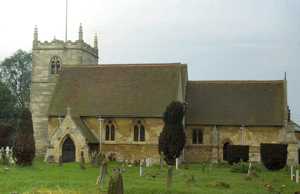For this church:    |
 CoddingtonAll SaintsNewark Archdeaconry Newark and Southwell Deanery IntroductionWe do not know when the first church building was constructed – a modest-sized stone building, judged to be of the 13th-14th century, survived in a poor state of repair until the mid-19th century. In 1864-5, shortly after the parish was separated from East Stoke, the church was substantially demolished and rebuilt by G F Bodley – on its original foundations, retaining the tower (encased in ashlar) and reusing stonework elements judged to be of architectural merit (mainly the arcades, doors and most windows). The church enjoyed the patronage of the Thorpe family who were instrumental in its renovation and embellishment. Three additional Morris & Co windows were inserted in the South aisle in 1881-2. Bodley's gilded oak screen with figures of saints was inserted in 1890-1, and it is possible that the painted decorative scheme dates from then rather than the 1860s. Michael Hall, curator of the 2007 Bodley Centenery Exhibition at the Victoria & Albert Museum, described the church as an intriguingly transitional work — architecturally hard-edged, but the fittings and glass more compatible with Bodley's revised style after All Saints, Cambridge in 1862. The church is associated with the revival of Mothering Sunday as a religious festival in the period 1910-1940. Campaigner Constance Penswick Smith was the daughter of Coddington's incumbent Rev Charles Penswick Smith. The south aisle chapel is now dedicated to her memory and her family's gravestones are grouped by the south porch. Particular thanks to Jackie & David Armstrong and Hugh Daybell for research on this entry |





